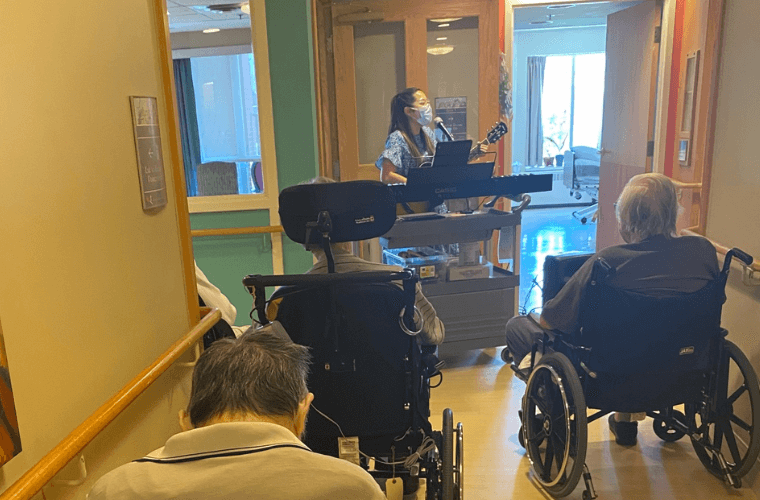Music has the power to bring us together in our community. Kensington Health has created a Spotify playlist of staff favorites, with songs from different genres and decades.
The pandemic isn’t over yet and we are continuing to make strides to keep each other safe, whether through social distancing, isolating, or getting vaccinated. It has been a challenging year as constant lockdowns can be exhausting. Thankfully, restrictions have loosened, and for some, life is feeling less stressful.
It can be difficult to stay positive during the pandemic, but research has shown listening to music can swiftly transform one’s overall well-being. In one randomized study from the Frontiers in Medicine, researchers found that over 30 per cent of elderly people who have mild to severe dementia and participated in group musical therapy had a better quality of life from listening to music.
In the beginning of this pandemic at Kensington, music played an important role in lifting spirits for residents. Communities rallied (safely) to cheer, clap, sing and play music to acknowledge health-care professionals working on the frontlines as well as those living in long-term care and hospice.
Music also promotes relaxation, and many people might not be aware of the role it plays for people living in long-term care and hospice and their mental, emotional, and physical well-being. Music therapy uses different interventions such as listening, playing an instrument, or writing songs. Additionally, it offers immense advantages through a therapeutic-based relationship.
Sarah Cheung is a Music Therapist who works with people living at The Gardens. Sarah leads one-on-one and group sessions with the residents and spends her time exploring the role of music in each resident’s lives. By using a variety of music therapy techniques, Sarah can easily connect and build a strong lasting relationship with the people she works with.
When it comes to the advantages to music, Sarah notes that there are beneficial outcomes: “Listening to music has a variety of powerful effects on our minds, which can lead to some significant effects on our bodies as well. It can drastically impact and shift our moods, like going from being sad to happy, and can help us experience and process a wide range of emotions that may be difficult for us to explain in words,” says Sarah.
When restrictions in The Gardens were loosened and the residents were able to resume music therapy, Sarah had noticed an instant change in their mood: “You can just tell how much the residents missed music, and the immediate change in emotion and expression when we started transitioning in-person music therapy sessions back into The Gardens,” says Sarah. “We have been able to have social distanced hallway concerts, and you see residents who do not speak as much anymore start to open up and become more expressive.”
Music therapy is a communicative and artistic way to express yourself when using words may be complex: “The most important aspect of music therapy is that it can present someone an opportunity to communicate through music when words are not accessible, or they are having difficulty finding the right words to use,” said Sarah. “Having another means to communicate, speak, and express yourself in a creative way is incredible because it transcends just using words to communicate.”
Music has played a vital role at Kensington Health. As for Music therapy, it can be a great way to support one’s mental and physical well-being.
To help continue to bring the community together, Kensington Health has created a Spotify playlist of staff favorites, with songs from different genres and decades with many to choose and dance too. If you have a song that you would like to have in the playlist, please send an email to communications@kensingtonhealth.org.
